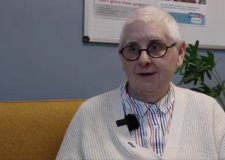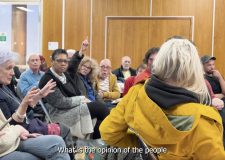St Helen’s Church: The future of Brighton’s oldest working building
The stewards of some of our finest buildings face tough choices which will also affect the people they serve of all faiths and none. Frank le Duc reports

Brighton and Hove’s oldest working building stands half way up a hill in Hangleton at the top end of a park. But not for the first time there are fears for the future of the building, St Helen’s Church. A few years ago it was threatened with closure after an official review. And if the priest in charge, Father Keith Perkinton, leaves or retires, the future of St Helen’s will once more be in doubt.
Father Keith is quick to point out that he isn’t about to do either. But members of his congregation have set up a support group, Friends of St Helen’s, to try to save the church. The group says on its website: “The Friends of St Helen’s has been set up following the very real threat that, due to our dwindling finances, we may lose our beautiful 11th century medieval church.
“Through publicity and events we hope to raise awareness of the plight of St Helen’s and the importance of keeping it open as a full time place of worship and community. Our aim is to increase our finances sufficiently to ensure that Brighton and Hove’s oldest building is maintained for those who love it today and for future generations.”
Many in the Church of England (CofE) are quick to point out that a church is more than the building where the congregation meets to worship. But for most people the church is a physical building and often an old and beautiful building at that.
Father Keith said: “We’re guardians of a very special building. It’s quite a responsibility. It’s a very strong building. I believe that a building that was made for worship should be kept for worship. Churches can be sermons in stone and actually say something. They’re very powerful pieces of art. We’re using the strength that we have to try to raise awareness of our worshipping community.”
Community central
Like many of Brighton and Hove’s churches, it is open to community activities involving many people who are not religious and do not go to church on a Sunday. At St Helen’s a kindergarten meets five days a week in the church hall in Hangleton Way. Father Keith is also keen for the church itself to be open more often during the day as a place for “quiet silent prayer”. He has left the building open in the past but it was damaged.
And like many of Brighton and Hove’s churches, St Helen’s is keen to pay its financial way. When the last formal review was published, in March 2005, it made worrying reading for parishioners. There are now a few more members on the church’s electoral roll – almost 100 – and they contribute more than in the past.
The parish contribution to the diocese – the church’s area office – was assessed as £60,000 last year. Few churches in Brighton and Hove pay the full amount. Instead the Diocese of Chichester – which includes the deaneries of Brighton and Hove – uses its reserves to make up the shortfall. The contribution goes towards the cost of paying the clergy, including a rising sum for pensions. It also covers the cost of housing, training and church insurance. But the diocese recorded a £440,000 shortfall last year. Before long it may have to take radical steps.
Over-churched?
The review that shocked parishioners at St Helen’s also served as a wake up call to many others in the area. There are about 50 CofE churches in Brighton and Hove – a few less than when the 2005 review was published – and many churches belonging to other denominations. But despite a small number of closures, the area is still regarded as “over-churched”. Some priests now look after more than one church and others share a team or group ministry. Many rent out space to community groups or host events such as concerts.
At St John the Baptist in Hove the church leases space for the St John’s Centre and Café to Brighton and Hove City Council which outsources it to a charity called Impact. The centre caters for over-60s. And another part of the church has been set aside for the Cornerstone Community Centre.
The Rev Paul Doick has been at St John’s for almost eight years. He said: “We’ve inherited these wonderful buildings that were put up in Brighton and Hove generally by the Victorians who had this wonderful foresight that every community should have a church and a pub. But I wish I could spend less time worrying about the maintenance of the building.
“We’ve been left with a legacy. The churches that survive will be those which don’t just have a worshipping community. They will be the ones used by the wider community. When you’re working in partnership with the community it helps.” While the church membership has roughly doubled to 140 over the past ten years, the building is now used by about 1,500 people a week from the immediate area.
He said that St John’s had been helped with its building restoration by a grant of about £100,000 from English Heritage and a contribution from the National Churches Trust. And that the general financial position had improved. But as a former banker Mr Doick is under no illusions about the challenges faced by his church and others. He said: “The important thing for us is that the church is there to serve the whole community. We are here for everybody whether they have a faith or none.”
Money worries
At All Saints in The Drive, in Hove, Father Phil Ritchie said: “We need to spend about £250,000 on the roof. Other than that, we’re not in bad nick. We operate at a very big deficit and we can only do that for a couple more years before we don’t have any money at all. Our problem is that we’re a massive church in a city where largely people don’t go to church.
“The reality is that we’ve got a big building that can comfortably seat 800 people and we get about 140 on a Sunday. They’re mostly old people or young families, neither of whom have much money. We’re trying to make it more of a venue and have events but that comes at a cost.
How much is faith connected to these buildings? Should we move out and leave them to other people to look after? Can these dry bones live? The answer is, we don’t know.”
It’s a question that was faced by the landmark St Peter’s Church in Brighton which for a long time it had a dwindling congregation. It brought to mind the Bible verse about two or three gathered in my name. A young and energetic team arrived in November 2009 led by the Rev Archie Coates. They have begun a transformation.
From a couple of dozen worshippers, the numbers attending three services on an average Sunday now reach 600 to 700. They raised £150,000 towards match-funding an English Heritage grant to make the building and its roof watertight. More work is needed. St Peter’s pays its way under an agreement that was reached when Mr Coates arrived. The church had been declared redundant and had been subject to a campaign to save it as a place of worship. Some feared it would be demolished.
Many who campaigned were not churchgoers but people who appreciated the beauty of the building, designed by Parliament’s architect Charles Barry. Like his counterparts across the area Mr Coates has put a great deal of effort into Holy Week and Easter celebrations. But it’s hard to put money and building work completely out of mind. He said: “We don’t hold any reserves. We’ve got about three months’ money in the bank. It keeps me accountable to the church! I don’t know whether we can save the building because it’s a huge job but I do know that we’ve got to build the congregation.”
Brighton & Hove City Council leader Jason Kitcat on Big Dig Week
March saw over 20 local volunteer-run food growing projects open their gates to fledgling green-fingered enthusiasts as part of the nationwide Big Dig Week (16–24 March).
Big Dig Week coincides with the start of the growing season and is supported locally by Harvest Brighton & Hove, which supports community gardens and helps people grow their own food.
Despite the damp start, city residents flocked to activities across the city, including building vertical salad gardens, wild flower sowing and fruit growing. In the process, they were able to learn about urban spaces near their homes, try out produce grown in the city and learn new gardening skills. And the help offered by local people will have given many projects a big boost in their final preparations for the spring season.
There are over 60 community gardens across Brighton & Hove, all run by local volunteers. They offer the chance for people to learn skills and knowledge about food and where it comes from. But they also are an opportunity for people to meet and socialise, as well as give something to their local community. Many pieces of derelict or otherwise unused land are becoming productive spaces that everyone can enjoy. One of the first projects open during the week was the London Road Station Garden. What used to be a barren strip of land is has now been overhauled and given a new lease of life by volunteers, who, prepared beds and sowed salad vegetables.
If you weren’t able to pop along, don’t worry – many community gardens run open days throughout the year, and are always looking for new volunteers to drop in and help out while learning new skills.
For more information on community gardens and food growing, and to find your nearest community garden, visit Harvest Brighton & Hove at www.harvest-bh.org.uk



















